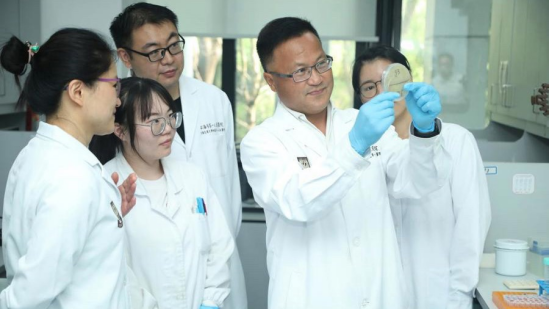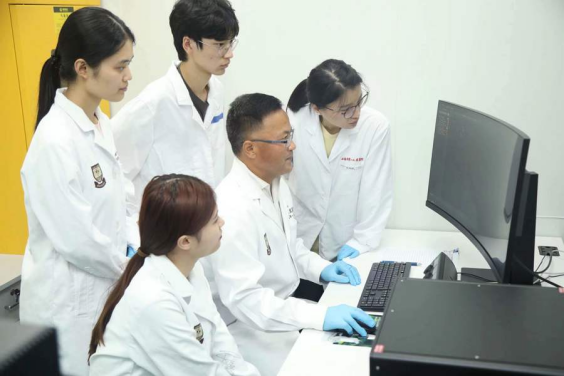- News
Three Patents of Ten Million Yuan Scale Were Successfully Signed and Transferred Within One Week; Shanghai General Hospital Makes the “Sleeping Patents” Alive
Source: https://www.shobserver.com/staticsg/wap/newsDetail?_channel=appshare&id=675247
The institute-research-industry combination enables the clinical needs and market demands to be met more accurately.

On October 28, Shanghai General Hospital officially signed a contract of technology transfer with Guangdong Taienkang Pharmaceutical Co., Ltd. on the patent product of "immune age diagnostic kit" developed by the research team of Professor Honglin Wang, who serves as the Executive Vice Director of the Clinical Research Institute and the Director of the Precision Research Center of Difficult Diseases. The first payment of the contract amounted to 30 million yuan.
Just two days before the contract signing, another two patented technologies were also successfully signed and transferred, the total transferring amount of which reached ten million dollars. One of the patented technologies is "a kind of corneal negative pressure suction ring" developed by Professor Hui Zhao's research team from the Ophthalmology Clinical Medical Center. The other one is “detection method and its application of basophil’s vitality” developed by Xia Peng and Li Li’s team from the Department of Laboratory Medicine.
It is not only the dedication of professional researchers and doctors in both scientific research innovation and clinical work but a number of supportive initiatives and policies launched by our hospital in recent years that enables the successful transformation of a galaxy of important research results.
In order to break the gap between scientific research results and actual products which is also known as “the last kilometer”, we applied multiple incentive policies to help research projects meet the clinical needs and market demand from the origin, offering helps in the first phase of the result transformation which is also known as “the first hundred meters”, so as to awaken the “sleeping patent” in the documents and reports to benefit more patients with clinical practice.

The research team is conducting data analysis.
The "first hundred meters" makes the "last one kilometer".
On December 17, 2022, the document --Rules for promoting the transformation of scientific and technological achievements of medical and health care institutions (on trial) jointly issued by Science and Technology Commission of Shanghai Municipality, the Municipal Health Commission and other eight departments officially came into force, in which establishing a mature intellectual property inventory mechanism to awaken the "sleeping patents" was put great emphasis on.
"Sleeping patents" refers to medical technology achievements that have already been authorized by patents but have not been transformed into actual products yet. "In fundamental and clinical research, there is often an awkward situation. Expert teams spent months and years conducting research and made achievements which are of great academic value, only to find being turned down by the market, which stands in the way of benefiting the patients.” , said Mr. Yanhong Zhu, director of the Scientific Research Department.
How to break the "last one kilometer" gap? We have our own solution-- To offer market-oriented research guide and establish corresponding platforms for the cooperation of clinical research and real products in order to get through the “first hundred meters” smoothly, making the market pay for the products. Expand the cooperation network and take the market needs as priority, preventing the problem that experienced scientific researchers and doctors are only sensitive to what is of high clinical value however cannot meet the real need from the origin.
For this reason, in recent years, we have been constantly working on advancing in-depth cooperation in cell therapy, medical imaging, artificial intelligence and minimally invasive technology with companies that have leading positions in their respective fields such as Origincell, United Imaging, Microport, etc. In addition, we have also established joint research centers for medical robotics and advanced medical materials in collaboration with various universities, including Shanghai Jiao Tong University, Shanghai University of Technology and so on. Joining hands with universities, enterprises and institutions, we have created a medical innovation community and have set up an innovated demonstration base of research-enterprises integratio
The three parties -- institutes, universities and industries working together helps to improve clinical diagnosis and treatment.
The advantage of the three crucial parties including medical institutes, universities and medical industries joining hands together lies in having the ability to more accurately match the clinical needs and market demands, fully predict the feasibility of innovative projects, and thus improve the efficiency of future transformation. That is to say, when doctors take inspiration from clinical problems encountered, they can set about relative scientific research, and at the same time work with enterprises that knows clearly the marker needs to design targeted patented products.
A typical case is the "immune age diagnostic kit" technology project which previously signed contracted with Guangdong Taienkang Pharmaceutical Co., Ltd. According to project leader Professor Honglin Wang, when his research team first found that the disease progress of patients with viral infections is closely related to their immunity, their urgently concern was to explore a quantified way to appraise the immunity conveniently and accurately, providing an important reference for clinical diagnosis and treatment.
To this end, the research team analyzed human bone marrow tissue samples from ages 3 to 91 through high-throughput single-cell sequencing, and discovered an immunological indicator that can characterize the aging of the body. Quantifying this indicator in vitro, research team realized the possibility to accurately assess the body's "immune age" through micro peripheral blood during medical checkups and other processes, and provided an early warning sign of inner danger.
During the research process, the research team, hospitals and companies had been keeping in close touch, working together to constantly optimize the research results according to the latest market demand and transformation expectations. With such joint efforts, the final product Professor Wang’s team made can conduct accurate assessment of the human body’s immune age only taking 1 ml of samples, spending 1 hour of time and focusing on 1 major indicator. It is reported that this product has great application prospects in the field of physical examination, age-related diseases, moderate to severe inflammation and cancer risk screening, and is expected to become the first class III medical device approved for accurate detection of human immune age.
Aside from the platforms and hardware, we have also designed a refined project management mode to arouse enthusiasm for scientific research and enhance the output of results through the establishment of a clinical research-oriented appraisal system, the implementation of precise resource allocation, and the formulation of scientific and technological incentive policies. Under a series of measures to boost and encourage scientific research and innovation, a total of 22 medical research achievements have been successfully transformed in the past five years, with a sum of nearly 20 million yuan. Moreover, in 2022, Shanghai General Hospital has officially been approved to be a technology transfer and transformation service organization in Shanghai.
"To promote clinical research in such medical institutions of municipal class as our hospital, it is always our first intention and top priority to improve the quality of medical care and enhance people's health and well-being. As a result, we have been working hard on developing applicable technologies and equipment by turning clinical problems into scientific research, and improve the clinical diagnosis and treatment with the research result. ”, said Bangmin Han, who works as the vice director. He also noted that we will continue to stick to the two major goals during the transformation of the institute. Clinical diagnosis and treatment and clinical innovation will be of the same importance, and the development focus will be transferred from diseases to people’s health so as to promote the integration and innovation of medical institutions and enterprise, speed up the transformation of scientific research results, enhance the quality of clinical research as well as the innovation in medical science and technology, and ultimately benefit the patients.
